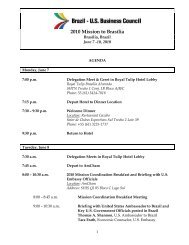Environmental Permits - Brazil-US Business Council
Environmental Permits - Brazil-US Business Council
Environmental Permits - Brazil-US Business Council
- No tags were found...
You also want an ePaper? Increase the reach of your titles
YUMPU automatically turns print PDFs into web optimized ePapers that Google loves.
How to obtain environmental permits in <strong>Brazil</strong>American Chamber of Commerce for <strong>Brazil</strong> – AMCHAMInternational Affairs Department<strong>Brazil</strong>, 2010
How to obtain environmental permits in <strong>Brazil</strong>
environment&energyCONTENTSENVIRONMENTAL PERMITS......................................................................................6NATIONAL ENVIRONMENT SYSTEM (SISNAMA)......................................................6LICENSING RESPONSIBILITY.....................................................................................7LICENSING TYPES AND PHASES..............................................................................10ACTIVITIES SUBJECT TO ENVIRONMENTAL LICENSING.........................................11ANALYSIS TIME FRAME............................................................................................17VALIDITY TIMES.......................................................................................................18ADMINISTRATIVE PROCEDURE...............................................................................19ENVIRONMENTAL IMPACT ASSESSMENT................................................................20ENVIRONMENTAL IMPACT STUDY AND REPORT (EIA/RIMA)................................20PUBLIC HEARING....................................................................................................23LEGAL REFORM.......................................................................................................24ADMINISTRATIVE INFRINGEMENTS AND ENVIRONMENTAL crimes...................27
6How to obtain environmental permits in <strong>Brazil</strong>ENVIRONMENTAL PERMITSAn environmental permit is an important instrumentto prevent environmental damages and monitor environmentalquality. In the licensing procedures thePublic Administration establishes the conditions andlimits for the installation and operation of activitiesthat may cause adverse environmental impact.<strong>Environmental</strong> licensing is, thus, the administrativeproceeding through which environmental agencieslicense the location, installation, expansion and operationof enterprises and activities that use environmentalresources and that are regarded as actually orpotentially pollutant, or those which may, in anymanner, cause environmental degradation.The requirement for an environmental permit is establishedin article 9, section IV, of the National <strong>Environmental</strong>Policy Act, Federal Law no. 6938, datedAugust 31, 1981, and in Resolution no. 237, datedDecember 19, 1997, issued by CONAMA – NationalEnvironment <strong>Council</strong>, as well as in State and Municipallegislation.NATIONAL ENVIRONMENT SYSTEM (SISNAMA)The National Environment System – SISNAMA – reflectsthe <strong>Brazil</strong>ian federation and consists of federal,state and local or municipal agencies that are responsiblefor environmental protection and the improvementof environmental quality.These agencies have joint responsibility to protectthe environment and, thereby, they may issue environmentalpermits, inspect the installation and operationof projects and activities and exercise their policepower to demand legal compliance, whichinclude administrative penalties and the embargo ofactivities. <strong>Environmental</strong> agencies have legal standingto bring law suits in federal and state courts.At the federal level, the <strong>Brazil</strong>ian Environment and RenewableNatural Resources Institute – IBAMA – is thefederal agency responsible for the preservation, conservation,inspection, control and sustainable use of naturalresources. As IBAMA is not capable of overseeingthe full territorial extension of <strong>Brazil</strong>, a country as largeas the United States, half of it covered by the AmazonForest plus a variety of other regional differences, stateand municipal agencies are the true base of SISNAMA.
environment&energy 7LICENSING RESPONSIBILITYFederal Law no. 6938/81 (National EnvironmentPolicy Act, article 10) provides that environmentallicensing by a state agency is required for the “construction,installation, expansion and operation ofbusinesses and activities which use environmentalresources regarded to be actually or potentially capableof causing environmental pollution or degradation.”IBAMA may issue a supplemental permit,if necessary.As provided in article 10, § 4 of the aforesaid FederalLaw, IBAMA is responsible for environmental permitsof activities that may cause significant regional or nationalenvironmental impact. In this regard, sectionIII, article 1, of CONAMA Resolution 237/97 establishesthat “regional environmental impact is an impactwhich directly affects, either in whole or in part,the territory of two or more States”.In order to settle misinterpretation of the law concerningwhich agency would be responsible to issueenvironmental permits (whether federal, state or municipalor all of them jointly), CONAMA Resolutionno. 237/97 (article 7) provides that environmentalpermits will be issued by a single agency only, asprovided in articles 4, 5 and 6 of the resolution.IBAMA’s federal responsibility (article 4) is restrictedto projects and activities:“I – located or jointly developed in <strong>Brazil</strong> anda neighboring country; in the territorial sea;on the continental shelf; in the exclusive economiczone; in Indian lands and in federalconservation areas;II – located or developed in two or morestates;III – which cause direct environmental impactsthat exceed the territorial limits of thecountry or of one or more states;IV – intended for researching, mining, producing,improving, transporting, storing, andhaving radioactive material, at any stage, orwhich uses nuclear energy on any of its modesand applications, as determined by the NationalNuclear Energy Commission – CNEN;V – related to military bases or enterprises,when applicable, according to specific legislation”.At the other end, local or municipal responsibility isrestricted to projects and activities that may cause localenvironmental impact and those which are delegatedto local government by the State (article 6).Actually, just a few <strong>Brazil</strong>ian municipalities have is-
8How to obtain environmental permits in <strong>Brazil</strong>sued environmental permits due to not having thetechnical capability or not meeting the required legalstandards.Finally, article 5 provides that state environmentalagencies may issue environmental permits for projectsand activities which are:“I – located or developed in more than onemunicipality or in state conservation areas;II – located or developed in forests and otherforms of natural vegetation allocated to permanentpreservation, as listed in article 2 ofLaw no. 4771, dated September 15, 1965, andin all those which are regarded as such by federal,state or local legislation;III – cause direct environmental impacts beyondthe territorial limits of one or more Municipalities;IV – delegated by the Federal Government tothe States or the Federal District.”In this regard, the state environmental agency willproceed with the required environmental licensingprocedure after considering the technical examinationperformed by the environmental agencies ofthe Municipalities where the project or activity willtake place, as well as – when appropriate – theopinion issued by other pertinent agencies (article5, sole paragraph).Because this CONAMA Resolution addressed and alteredthe federative jurisdiction criterion establishedby the National <strong>Environmental</strong> Policy Act of 1981(article 10), numerous legal issues were raised as toits legality and constitutionality, in view of article 23,sole paragraph, of the <strong>Brazil</strong>ian Constitution whichprovides that the joint cooperation of federal, stateand municipal agencies will be determined by a constitutionalcomplementary law, thus a CONAMAresolution would not be the appropriate legal venueto establish agency responsibility or jurisdiction.Numerous lawsuits have been filed by federal andstate environmental agencies, as well as by the PublicProsecution Office, before federal and state courtsto determine environmental licensing responsibilitybut have obtained erratic results from the courts.
environment&energy 9The prevailing legal parameter in the <strong>Brazil</strong>ian doctrine(scholar interpretation of the law) considers theimpact outreach of a proposed project or activity,rather than the location or the ownership of the impactedarea, such as confirmed by recent federalcourt jurisprudence (case-law):“<strong>Environmental</strong> licensing: The responsibilityto license a construction project or an activitywhich is potentially harmful to the environmentis not established by the ownershipof the assets contemplated in it, but by theirpossible environmental impacts.” (TRF 5thReg., 3rd T, Fed. Justice Ridalvo Costa, AC 327022,DJ 17.05.2003, p. 659).Even so, the direct impact outreach criterion is not aneasy task to assess in view of the variables analyzed,case by case, of the multiple factors that make up thephysical, biological, and socio-economic environments.Among the evident extreme situations betweenthe merely local impacts and others clearly regional ornational, situations remain where it is not easy to demarcatethe thin separation line between intrastateand interstate impacts, in order to define the responsibilityof the federal or state agency, respectively.
10How to obtain environmental permits in <strong>Brazil</strong>LICENSING TYPES AND PHASESThe Federal Decree no. 99274, dated June 6, 1990,and CONAMA Resolution no. 237/97 establish threestages for environmental licensing:i) Preliminary License (LP), issued at the initial phaseof a project or activity planning, containing the basicrequirements to be complied with in the location,installation, and operation phases, upon observingthe federal, state or local soil use plans;ii) Installation License (LI), issued to start constructionor implementation of a project or activity accordingto the specifications contained in the approvedexecutive project;iii) Operation License (LO), issued, after the requiredverifications, to start the operation of the licensed activityand its pollution control equipment, as specifiedin the preliminary and installation permits.State laws may add and detail in greater length thevarious typologies of environmental permits, suchas is the case with State Law no. 12916, dated November8, 2005, in the State of Pernambuco, whichkeeps the same licenses as those of the federal systemand adds the Simplified License (LS) and Authorization,as follows:Authorization – issued to authorize, on a precariousand discretionary basis,the performance of activitiesthat may alter the environment for a shortand certain time period, but do not cause any significantimpacts;Simplified License (LS) – Granted for the location,installation and operation of small and very small enterprisesor activities, which present a low pollutingor degrading potential.Typically, in order to set up a business or an activitywhich potentially causes environmental degradationor pollution it is necessary to request a preliminarylicense or permit to the environmental agencyin the initial planning stage, while still at a basicproject level. The preliminary permit does not authorizeany construction or the implementation ofany activity. Its sole purpose is to inform the interestedparty of the environmental feasibility of theproject at the intended site.Once this phase is completed, the issuance of theinstallation permit will allow the project to be implemented.Finally, after the required inspections, theoperation permit may be issued to start the operationof the activity and its control equipment.
environment&energy 11ACTIVITIES SUBJECT TO ENVIRONMENTAL LICENSINGAnnex I to Resolution 237/97 lists the enterprisesand activities which are subject to environmentallicensing:Mineral Extraction and Treatment• Mineral research with a usage guide;• Open air prospect, including of alluvion, withor without processing;• Underground prospect with or without processing;• Mining prospect;• Well drilling and oil and natural gas production;• Processing of nonmetallic minerals, not associatedwith extraction;• Manufacturing and preparation of nonmetallicmineral products such as: production ofceramic material, cement, plaster, asbestosand glass, among others.Metallurgical industry• Manufacturing of steel and steel products;• Production of steel and iron castings/forged/wires/rerolled items with or without surfacetreatment including galvanoplasty;• Metallurgy of nonferrous metals, in primaryand secondary forms, including gold;• Production of rolled items/alloys/artifacts ofnonferrous metals with or without surfacetreatment, including galvanoplasty;• Rerolling of nonferrous metals, including alloys;• Production of welds and anodes;• Metallurgy of precious metals;• Powder metallurgy, including molded parts;• Manufacturing of iron/steel and nonferrousmetal artifacts with or without surface treatment,including galvanoplasty;• Steel hardening and cementation, wire annealing,surface treatment.
12How to obtain environmental permits in <strong>Brazil</strong>Mechanical industry• Manufacturing of machines, appliances, parts,fixtures and accessories, with and without surfaceand/or heat treatment.Communication, electric, and electronicmaterial industry• Manufacturing of batteries, cells and other accumulators;• Manufacturing of electrical, electronic materialand equipment for telecommunications andIT;• Manufacturing of electrical and electrical homeappliances.Wood industry• Sawmill and wood development;• Wood preservation;• Manufacturing of sheets and plates in particleboard,plywood and compressed wood;• Manufacturing of wood and furniture structures.Paper and pulp industry• Manufacturing of mechanical paste and pulp;• Manufacturing of paper and cardboard;• Manufacturing of paper, cardboard, pasteboard,card, and compressed fiber artifacts.Transport material industry• Manufacturing and assembly of road and railvehicles, parts and accessories;• Manufacturing and assembly of aircrafts;• Manufacturing and repair of vessels and floatingstructures.Processing of natural rubber• Manufacturing of inner tube, and manufacturingand overhauled tires;• Manufacturing of rolled items and rubberthreads;• Manufacturing of rubber foam and rubber foamartifacts, including latex.
16How to obtain environmental permits in <strong>Brazil</strong>• Marinas, ports and airports;• Ore, oil and chemical products terminals;• Chemicals and hazardous products warehouses.Tourism• Touristic and entertainment complexes, includingtheme parks and motor circuits.Diverse activities• Soil plotting;• Industrial district and center.Agricultural activities• Agricultural project;• Livestock raising;• Settlement and colonization projects.Use of natural resources• Silviculture;• Economic exploitation of wood or firewoodand forest by-products;• Activity for the exotic fauna management andwild fauna nursery;• Use of the natural genetic assets;• Management of live water resources;• Introduction of exotic and/or genetically engineeredspecies;• Biotechnology use of the biologic diversity.The states may set out more comprehensive criteriathan the federal legislation and, thereby, include otheractivities which are not listed in Resolution 237/97.Therefore, it is recommended to consult the state legislationon environmental permits, because any activitywhich uses natural resources or which may, by anymeans, cause environmental degradation is subject toenvironmental licensing, as noted in Annexes I and IIof the State of Pernambuco at the end of this guide.
environment&energy 17ANALYSIS TIME FRAMEThe federal legislation does not set specific time framesfor the analysis of licensing applications, which mayextend over a number of years. However, some stateshave already set administrative deadlines for grantingthe permits and respective renewals, as is the casewith Pernambuco:“Art. 12. The CPRH [acronym for the state licensingagency] may stipulate different analysistime frames for each permit, in view ofthe activity or enterprise peculiarities, aswell as for the formulation of supplementaryrequirements, as long as the maximum three(3) month time is observed, starting from theact of filing the application to its granting ordenial. When an <strong>Environmental</strong> Impact Study(EIA) and respective <strong>Environmental</strong> ImpactReport (RIMA) or public hearing are required,the time frame will be up to twelve(12) months.§ 1. The CPRH will analyze the requests for environmentallicense renewal in no later thanthirty (30) days.§ 2. The time count provided in the caption ofthis article will be suspended during the preparationof supplementary environmental studiesor the requirement for clarification or supplementationsabout the project.”
18How to obtain environmental permits in <strong>Brazil</strong>VALIDITY TIMESThe validity times for the federal environmental permitsare set forth in article 18, of CONAMA Resolution237/97:a) The preliminary license (LP) cannot be longer thanfive (5) years;b) The installation license (LI) shall be at least thelength established in the works schedule, but it cannotbe longer than six (6) years; andc) The operation license (LO) shall consider the environmentalcontrol plans, and be a minimum of 4 fouryears and a maximum of 10 years.The provisions of state legislation should always betaken into account, as these may be more restrictive.In the case of the State of Pernambuco, for example,article 5, of Law no. 12916/2005, establishes:“§ 1. The preliminary license validity time cannotbe longer than two (2) years, and shall takeinto account the schedule for drawing up theplans, programs and projects of the enterpriseor activity.§ 2. The installation license validity time cannotbe longer than four (4) years, and shalltake into account the schedule for setting upthe enterprise or activity.§ 3. The operating license validity time shallconsider the environmental control plans,and be determined between one (1) year andten (10) years, according to the activity sizeand the polluting potential, …, ensuring theenterprises with a low polluting potential avalidity time of minimum two (2) years.§ 4. The operation license (LO) for real estateenterprises in which sanitary drainage is via acesspit system will be granted for an indeterminatetime.§ 5. The preliminary license (LP) and the installationlicense (LI) may have their validitytimes extended for one time only, as long asthey do not exceed the maximum times setforth in §§ 1 and 2.§ 6. The extension referred to in the precedingparagraph shall be requested before theexpiration of the respective validity time and,in the case of the installation license, itshould only be possible in case no modificationhas been made in the project that wasinitially approved.”
environment&energy 19ADMINISTRATIVE PROCEDURETypically, the administrative procedure starts with therequest of a preliminary permit to the environmentalagency. A basic description of the project and environmentalstudies are attached to the request.After review of the proposed project and the environmentalstudies, the licensing agency will inspect thearea where the project is to be installed and may requestclarifications and/or supplementary information.When necessary, a public hearing will be held, accordingto the regulation provided in CONAMA Resolutionno. 9, dated December 3, 1987. New clarificationsand additional information deriving from thepublic hearing may be requested.Finally, a conclusive technical assessment will be issuedand, when appropriate, a legal opinion, whichwill determine the granting or denial of the permit.The licensing agency shall consider restrictions setforth by the municipality (local government) wherethe enterprise or activity will be located, as well as– when appropriate – the opinion by other relevantagencies involved in the licensing process.In the case of enterprises and activities with significantpotential environmental impact, the preparation of anenvironmental impact study (EIA) will be required.
20How to obtain environmental permits in <strong>Brazil</strong>ENVIRONMENTAL IMPACT ASSESSMENTThe <strong>Environmental</strong> Impact Assessment was introducedin the <strong>Brazil</strong>ian legal system by the National<strong>Environmental</strong> Policy Act, Federal Law no. 6938/81,and regulated by CONAMA Resolutions nos. 001/86and 237/97, among others which address more specificstudies for a given enterprise or activity.CONAMA Resolution no. 237/97 enlarged the conceptof environmental impact assessment beyond thetraditional and more comprehensive EIA/RIMA (<strong>Environmental</strong>Impact Study and <strong>Environmental</strong> ImpactReport), in such a way as to include any and all studiesreferring to the environmental aspects related to thelocation, installation, operation, and modification ofan activity, such as: environmental report, environmentalcontrol project, preliminary environmental report,environmental diagnostics, environmental managementplan, degraded area recovery plan andpreliminary risk analysis. Obviously, this list is illustrative,not exclusive, as there can be numerous otherenvironmental studies (article 1, section III).ENVIRONMENTAL IMPACT STUDY AND REPORT (EIA/RIMA)CONAMA Resolution no. 1/86 defined an environmentalimpact as “any change in the physical,chemical, and biological properties of the environmentcaused by any kind of material or energy resultingfrom human activities which, either directlyor indirectly, affects: (i) the population’s health,safety and well-being; (ii) social and economic activities;(iii) the biota; (iv) aesthetical and sanitaryconditions of the environment; and (v) the quality ofenvironmental resources”.This Resolution also detailed the basic criteria to preparean <strong>Environmental</strong> Impact Study (EIA) and respectiveEnvironment Impact Report (RIMA), as toolsof the National <strong>Environmental</strong> Policy Act and mandatoryfor licensing an activity that may potentiallycause significant environmental degradation.The following enterprises and activities must, necessarily,prepare and submit an EIA/RIMA to obtain anenvironmental permit (Resolution no. 1/86, article 2):“I – Highways with two or more driving lanes;II – Railways;
environment&energy 21III – Ports and ore, petroleum and chemicalsterminals;IV – Airports, as defined by section 1, article48 of Decree Law no. 32, dated 11/18/66;V – Oil pipelines, gas pipelines, mineral pipelines,conducting drains and sewerage outfalls;VI – Power transmission lines, above 230 KV;VII – Hydraulic works to exploit hydrologicalresources such as: dams for hydroelectricpowerpurposes, above 10 MW, for sanitization orirrigation, opening of channels for navigation,drainage and irrigation, water course rectification,opening of entrance bars and mouths,basin transposition, docks;VIII – Extraction of fossil fuel (oil, shale, coal);IX – Extraction of ore, including those of classII, defined in the Mining Code;X – Sanitary landfills, processing and final dispositionof toxic or hazardous wastes;Xl – Power generating plants above 10MW,whatever the source of primary energy;complex (petrochemical, steel, chlorochemicals,alcohol distilleries, coal, extraction andcultivation of hydrological resources);XIII – Industrial districts and strictly industrialzones – ZEI;XIV – Economic exploitation of wood or firewood,in areas above 100 hectares or lower,when reaching significant areas in terms ofpercentage and importance from the environmentalpoint of view;XV – Urban projects above 100ha or in areas ofrelevant environmental interest, at the discretionof federal, state and municipal agencies;XVI – Any activity using charcoal in a quantityabove ten tons a day.”In addition to the items indicated above, the environmentalagency may require that other enterprises,works or activities prepare an EIA/RIMA, if the projectand/or the environmental conditions in the surroundingsof the area to be impacted indicate that a potentiallysignificant environmental impact may occur.XII – Industrial and agroindustrial units and
22How to obtain environmental permits in <strong>Brazil</strong>The EIA/RIMA should be prepared according to theTerms of Reference provided by the environmentalagency and should contain, among other items: anenvironmental diagnosis of the area, description ofthe proposed action and its alternatives and identification,analysis and prediction of significant, positiveand negative impacts. This study should be presentedprior to and as part of the procedure to obtain thepreliminary permit.The EIA should observe a number of requirementsdefined by CONAMA Resolution no. 1/86, in keepingwith the changes provided in CONAMA Resolutionno. 237/97: define the boundaries of the geographicarea to be directly or indirectly affected bythe impacts, called area of influence, considering –in all instances – the hydrographic basin in which itis located; perform an environmental diagnosis of thearea where the project will be located and the surroundingarea of influence, both direct and indirect,regarding the physical, biological, and socioeconomicenvironment; contemplate technological andlocation alternatives of the project, and confrontingthem with the assumption that it will not be implemented;identify and systematically assess the environmentalimpacts generated by the activity duringthe installation and operation phases; consider governmentprograms and plans, both proposed for andin development in the area of influence of the project,and its compatibility with the proposed activity;list and explain the mitigating, potentializing andcompensating measures of the identified impactsand, finally, present the monitoring and follow-upprogram of the positive and negative impacts, indicatingthe factors and parameters to be considered.The RIMA, in turn, should be presented on an objectiveand appropriate way for easy understandingby the public at large. The information should bewritten in an accessible language, be illustrated bymaps, charts, tables, graphs and other visual communicationtechniques, in such a way as to allowunderstanding the project advantages and disadvantagesas well as all the environmental consequencesof its implementation. Copies will be available atdocumentation centers or libraries at the environmentalagencies, and will be sent to other controlagencies, such as: IPHAN – National Institute of Artisticand Historical Patrimony, ICMBio - ChicoMendes Institute for Biodiversity, the Federal andState Public Prosecution Offices, and the MunicipalEnvironment Department, among others. Advertisingthe RIMA is a key requirement for the publicagencies and the population to be able to expressthemselves (CONAMA Resolution no. 1/86, article9, single paragraph and article 11).
24How to obtain environmental permits in <strong>Brazil</strong>LEGAL REFORMThere are two bills in the National Congress that mightchange the current environmental licensing system.First, PLC 01/2010 is complementary to the 1988 FederalConstitution (article 23, sole paragraph) and willestablish the rules for the federative cooperationamong federal, state, and municipal environmentalagencies. It has been approved by the House of Representativesand is now at the Federal Senate, with thepossibility of being approved shortly. In second place,PL 3729/2004 will regulate the administrative procedurefor environmental licensing and environmentalimpact studies and assessment. This bill is still beingdiscussed at the House of Representatives.According to PLC 01/2010, article 7, IBAMA willhave the responsibility to issue environmental permitsof enterprises and activities:a) Located or jointly developed in <strong>Brazil</strong> and a neighboringcountry;b) Located or developed within the territorial sea, onthe continental shelf or in the exclusive economiczone;c) Located or developed in Indian lands;d) Located or developed in conservation areas createdby the Federal Government, except in EnvironmentProtection Areas (APAs);e) Located or developed in two (2) or more States;f) With a military nature;g) Intended for researching, prospecting, producing,processing, transporting, storing, and having radioactivematerial, at any stage, or which use nuclear poweron any of its manners and applications, as determinedby the National Nuclear Power Commission(CNEM); orh) Which meet the typology established by an act ofthe Executive Power, from the proposition of a Three-Party National Commission, ensuring the participationof a member from the National Environment<strong>Council</strong> – CONAMA, and considering the criteria ofsize, polluting potential, and nature of the activity orthe enterprise.On the other hand, the Municipalities should beresponsible to license enterprises and activities (article9):a) Which cause or may cause an environmental impacton a local level, according to the typology definedby the respective State Environment <strong>Council</strong>s,
environment&energy 25considering the criteria of size, polluting potentialand nature of the activity; orb) Located at conservation areas created by the Municipality,except <strong>Environmental</strong> Protection Areas(APAs).The States will remain with the residual responsibilityto issue environmental permits of activities whichuse environmental resources, actually or potentiallypollutant or capable, in any form, of causing environmentaldegradation, except as provided in articles 7and 9; and those located or developed in conservationareas created by the State, except in <strong>Environmental</strong>Protection Areas (APAs).Therefore, federal responsibility to issue environmentalpermits is restricted to the location criterion of anenterprise or activity in an area which is under federaldomain or exclusive federal interest regarding itstypology, such as military nature and radioactive material,as determined by federal law or executive act.The criterion of national or regional impact will nolonger be applied in order to determine IBAMA’s responsibilityto issue environmental permits.On the other hand, the prevailing criterion to establishmunicipal responsibility is that of local environmentalimpact, as well as that of location in a municipalconservation area. The state responsibilitywill be determined in case the enterprise or activitydoes not fall into the categories that provide for federalor municipal responsibilityConcerning APAs – <strong>Environmental</strong> Protection Area,PLC 01/2010 provides that the definition of the federativeentity responsible for the licensing will followthe criteria provided in letters a, b, e, f and h, sectionXIV of article 7, section XIV of article 8 and in lettera, section XIV of article 9, thus it allows for state environmentalpermits by exclusion.This new rule will probably reduce the numerouscases of conflicts of jurisdiction, which currentlycause legal insecurity regarding environmental licensing.Article 13 of PLC 01/2010 expressly providesthat environmental licensing will be issued bya single federative entity, thus avoiding duplication ofenvironmental permits.It also establishes that other agencies interested inthe environmental licensing procedure of a givenproject or activity may intervene, on a nonbindingway, before the agency that is responsible to issue thepermit or authorization, and must observe the respectivetime frames and procedures, thereby avoidingsuccessive delays caused by parallel proceduresby other agencies integrating SISNAMA.
26How to obtain environmental permits in <strong>Brazil</strong>PLC 01/2010 should also avoid the duplication of administrativepenalties, as it provides that only the actuallicensing agency may impose environmentalpenalties to a given enterprise or activity (article 17).With regard to the environmental licensing process,PL 3729/2004 will introduce numerous changes, asfollows:• Creation of Strategic <strong>Environmental</strong> Assessments(article 4);• Merger of the LP/LI/LO stages for simplifiedpermits (article 7);• Use of new available technologies in additionto those required by existing legal standards(article 8, § 1);• Balancing of greenhouse gas emissions (article8, § 2, IV);• Proof of economic/ financial good standing(article 8, §2º,VI);• Holding of one or more public hearings (article14); and• Project financing conditioned to prior environmentalpermit (article 18).The Strategic <strong>Environmental</strong> Assessment will occuras required by the environmental agency in the preliminarylicensing process of similar or related activities,or that are located in the same area of influence,to permit better analysis of their environmentalimpacts still at the planning phase and in an integratedmanner.Enterprises with lower potential to cause negative environmentalimpact may be submitted to a simplifiedlicensing procedure, replacing the requirement foran EIA/RIMA with another environmental study orthe provision of specific information, and the mergerof the three stages into two or only one, at the licensordiscretion. The licensing agency may also submitan activity located in an area already subject to environmentalzoning to a simplified process.The requirement to adopt new technologies, in additionto compliance to existing environmental standards,to balance greenhouse gas emissions, alongwith measures to minimize and compensate theseemissions, to exhibit proof of financial good standing,to hold multiple public hearings and to conditionproject financing to prior issuance of the environmentalpermit have been of significant concernto private sector industries and businesses. Thus, thepresent bill may still be subject of significant changesbefore its final approval.
environment&energy 27ADMINISTRATIVE INFRINGEMENTS AND ENVIRONMENTAL CRIMESFederal LegislationThe Federal Constitution (article 23) assigns joint administrativeresponsibility to federal, states and municipalagencies for environment protection and pollutioncontrol. Therefore, any agency of the threegovernment levels may act on behalf of the environment,without any of them excluding the other. As arule, they shall apply their own legislation to the specificsubject-matter as well as federal legislation.Federal Law no. 9605, dated February 12, 1998,known as the <strong>Environmental</strong> Crime Law, regards asan environmental administrative infringement all actionor omission which violates legal rules for environmentuse, protection and recovery. Federal Decreeno. 3179, dated September 21, 1999, providesspecific sanctions applicable to conducts and activitieswhich are harmful to the environment.Nearly all administrative infringements also correspondto environmental crimes, including to set upand operate an enterprise or activity without the necessaryenvironmental permit (Law no. 9605/98, article60), subject to confinement from one (1) to six (6)months or a fine, or both penalties cumulatively. Thepreparation or presentation of an environmentalstudy, opinion or report which is fully or partly falseor misleading (article 69-A) is also an environmentalcrime, and may be punished with imprisonment fromthree (3) to six (6) years, in addition to a fine.Federal environmental administrative penalties, as arule, are more stringent than those from state and municipallegislation, and may reach fifty million <strong>Brazil</strong>ianReais (R$ 50,000,000. 00) – approximately<strong>US</strong>$27,000,000.00 (twenty seven million dollars) atcurrent exchange rates –, in addition to the seizureand destruction of the product; work demolishment;among others (article 72).State LegislationIn the State of Pernambuco, Law no. 12916/05 providesthat the state environmental agency may “imposesanctions and penalties for an action or omissionleading to an environmental pollution or degradation,which fails to observe the legislation and relevant environmentaland administrative rules, as well as fails tocomply with regulatory provisions or technical requirementscontained in environmental permits” (art. 3).Companies operating in Pernambuco should strictlyobserve the rules contained in the chapter about administrativeinfringements and penalties under thislaw, as any conduct which breaches any of these legalprovisions may give rise to an environmental administrativeinfringement, which is punished with avariable fine from R$ 50.00 to R$ 10,000,000.00.
28How to obtain environmental permits in <strong>Brazil</strong>These provisions include the following actions: setup, build, test, grow, start or carry on with an actuallyor potentially environment polluting and degradingactivity without an environmental permit or indisagreement with the stipulated requirements of thepreliminary, installation, and operation permits orenvironmental authorization; fail to meet environmentalagency notification to adjust or issue an environmentalpermit; refuse to provide data or informationrequested by the environmental agency, fail tocomply in full or in part with Commitment Terms;hinder or hamper inspection by the environmentalagency; and provide false information or corrupttechnical data requested by CPRH – the State of Pernambucoenvironmental agency.The penalty may vary according to the nature of infraction,which are classified as minor, major and veryserious, depending on: the seriousness of the fact andthe risk or damage they may cause to the population’shealth, safety and well-being, as well as to the biotaand natural resources; the infractor’s past history as tothe failure to comply with the environmental legislation;the infractor’s economic condition; and attenuatingor aggravating circumstances. These punishmentsmay be raised to their maximum level in casethe infractor avails himself of artifices, cunning, simulationor embarrassment to the inspection.Minor infringements shall be punished with a penaltyfine between fifty <strong>Brazil</strong>ian Reais (R$ 50.00) and twothousand <strong>Brazil</strong>ian Reais (R$ 2,000.00); major infringementsshall be punished with two thousand andone <strong>Brazil</strong>ian Reais (R$ 2,001.00) to one hundredthousand <strong>Brazil</strong>ian Reais (R$ 100,000.00); and thevery serious ones shall vary between one hundredthousand and one <strong>Brazil</strong>ian Reais (R$ 100,001.00) toten million <strong>Brazil</strong>ian Reais (R$ 10,000,000.00). In instanceswhere sanctions are imposed due to the lackof a mandatory environmental permit, the penalty fineshall be equivalent to the cost of the permit.The administrative fine applies regardless of the infringer’sobligation to remedy the environmentaldamage caused and the imposition of civil and criminalsanctions, in addition to, among other things, theseizure of the products and instruments used on theinfringement; works embargo and demolishment;partial or total suspension of activities; suspension orcancellation of registration, permit or authorization;and prohibition to contract with the public administration.In case of recurrence of the same nature andseriousness, the penalty applied will be double theone previously imposed.
environment&energy 29Municipal LegislationIn addition to federal and state legislation, the investorshould consider local legislation as well. In Recife,capital city of the State of Pernambuco, for example,article 117 of the City of Recife <strong>Environmental</strong> Code,Law no. 16243/96, addresses administrative infringements.It regards as infringer every natural person orlegal entity, under public or private law, which causesdamage to the environment and to third parties by hisactivity, irrespective of proof of guilt.Without prejudice to applicable civil and criminalsanctions, the environmental infringer is subject tothe following penalties: I. written warning; II. variablepenalty fines according to the environmental damage;III. product or instrument seizure; IV. works, activityor enterprise embargo; V. temporary stoppage ofthe work, activity or enterprise.The environmental damages are classified as minor,major and very serious. A minor damage is regarded tobe that in which the effect is reversible immediately orin up to eight days. A major damage should be that inwhich the effect is reversible within a period longer thaneight days and shorter than one hundred eighty days. Avery serious damage is regarded to be that in which theeffect is reversible in the long run only (a period equalto or longer than one hundred eighty days) and/or jeopardizesthe community health and life.The environmental infringer, in addition to imposed penalties,shall be compelled to remedy the environmentaldamage as required by the environmental agency.The environmental infringements are subject to properadministrative procedures and will start with theissuing of the <strong>Environmental</strong> Infringement AssessmentNotice, which will specify the necessary elements foridentifying the infringer, the infringement and the imposedpenalty.The accused will have fifteen (15) days, as of the summonsor assessment notice, to submit the defense orto pay to the municipal coffers the penalty fines thatwere charged.The accused is ensured the right to ample defense andmay be represented by an attorney, may append documents,appoint witnesses and require an expert’ssurvey at his own expenses.<strong>Brazil</strong>ian Law ensures that no natural or legal personwill be charged or penalized for the same infractionmore than once. Federal Decree no. 3179/99 expresslyprovides, in article 8, that the payment of a penaltyfine for an environmental infringement imposed by aState or Municipality supersedes the imposition of apecuniary penalty by the federal agency as a result ofthe same factor. Administrative penalties and proceduresmay be subsequently reviewed by the Courts.
environment&energy 319. STORAGE AND TRANSPORT OF HAZARDO<strong>US</strong>SUBSTANCE BY PIPELINES9.1 Fuel Distribution Center9.2 Chemical Product Storerooms9.3 Chemical Product Loading and Unloading Terminals9.4 Pipeline Transport Systems9.5 Carriers of Loads in General9.6 Carriers of Hazardous Substances9.7 Reselling of Liquefied Petroleum Gas (LPG)10. DIVERSE WORKS10.1 Airports10.2 Ports10.3 Mooring Berths, Marinas and Piers10.4 Electric Power Transmission Lines10.5 Telephone System Transmission Network10.6 Cell Sites (CS) and Wireless Telephone Equipment10.7 Commercial Sheds, Clubs, and Showhouses10.8 Wind Farms10.9 Thermal Stations and Theme Parks10.10 Motor Circuits10.11 Water Course Rectification10.12 Opening of Entrance Bars, Mouths and Channels10.13 Pumping Stations10.14 Construction of Breakwaters, Buttressesand other Coastal Works10.15 Road Jobsites10.16 Ecological Trails10.17 Thermal Electric Generator10.18 Thermal Power Plants11. <strong>US</strong>E OF HYDROLOGICAL RESOURCES11.1 Exploitation of Mineral Water11.2 Dams and Docks11.3 Exploitation of Underground Waters11.4 Catchments and Treatment of Surface Waters11.5 Water Distribution Systems11.6 Water Mains
32How to obtain environmental permits in <strong>Brazil</strong>ANNEX IIENTERPRISES SUBJECT TOENVIRONMENTAL AUTHORIZATION1.1 Transports of Hazardous Substancesand Wastes1.2 Industrial Liquid Waste Control1.3 Readequacy and/or Modification of Control and/or Disposal (Incineration) of Solid Industrial andHospital Wastes1.4 Hydraulic Landfills and Growth of Beach Strips1.5 Maritime Dredging1.6 Dredging, Silt Removal and Earthworks1.7 Dredging1.8 Retaining Wall1.9 Street and Highway Paving1.10 <strong>Environmental</strong> Researches1.11 Urban Channel Lining
34How to obtain environmental permits in <strong>Brazil</strong>The International and Comparative Law Division workswith both private and public legal issues, having renderedinnumerous services to foreign nationals andgovernments, including international organizations(<strong>US</strong>AID) and the United Nations (The World Bank,FAO, UNEP), analyzing, auditing and developing legalprojects within international cooperative programs inSouth America and Africa, as well as drafting environmentallegislation in several countries.Pa r t n e r s:Ivon D´Almeida Pires Filho: Admitted to the <strong>Brazil</strong>ianBar Association since 1978. Division: <strong>Environmental</strong>, Internationaland Comparative Law. Education: OlindaSchool of Law (LL.B.); Tulane University School of Law(LL.M.); University of Virginia School of Law (LL.M. andS.J.D.). International Legal Consultant in Latin Americaand Africa. Member: <strong>Brazil</strong>ian <strong>Environmental</strong> Lawyers’Association; IUCN – The World Conservation Union ofNature (Legal Committee), Arbitration and MediationCenter of Pernambuco; and AMCHAM – AmericanChamber of Commerce / Recife Chapter (member of theBoard). Professor of <strong>Environmental</strong> Law.Sandra Pires Barbosa: Admitted to the <strong>Brazil</strong>ian Bar Associationsince 1993. Division: Administrative Law andUrban Law. Education: Federal University of Pernambuco(LL.B. and LL.M.). Professor of Administrative Law.Flávia Carolina de Souza Reis: Admitted to the <strong>Brazil</strong>ianBar Association since 1994. Divison: <strong>Environmental</strong>Law. Education: Catholic University of Pernambuco(LL.B.), Federal University of Pernambuco (LL.M.),University of Kent, England (LL.M.). Member: IAIA –International Association of Impact Assessment. Professorof <strong>Environmental</strong> Law.Cristiana Pragana Dantas: Admitted to the <strong>Brazil</strong>ianBar Association since 1994. Division: Tax Law. Education:Federal University of Pernambuco (LL.B.). Professorof Tax Law.Ricardo Kalil Lage: Admitted to the <strong>Brazil</strong>ian Bar Associationsince 1997. Division: Civil Law and CorporateLaw. Education: Catholic University of Pernambuco.Professor of Corporate Law.Rua Padre Carapuceiro, 54. Boa Viagem. Recife, PE51020-280 - <strong>Brazil</strong>Telephone: +55 81 3325-5100Fac-Simile: +55 81 3465-5855Email: pires@pires.adv.brWebsite: www.pires.adv.br
environment&energy 35





